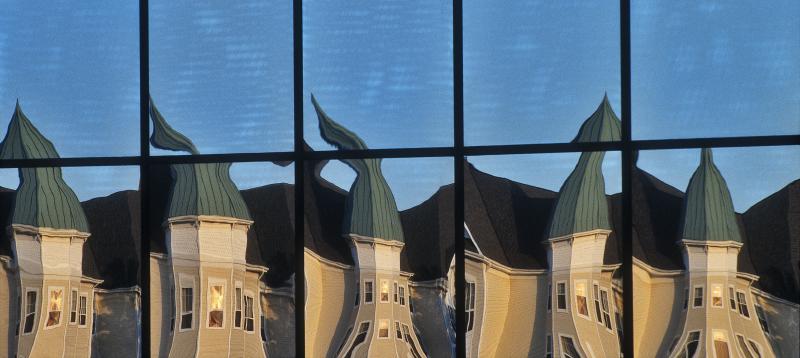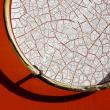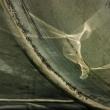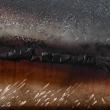Carl Root is a fine art photographer who is fascinated by patterns.
He looks for what he calls rhythm images, in which an image is repeated, with variations.
Much as variations in music are created when a melody/theme is repeated with variations in tempo or key, in Root's images the subject (theme) change within each repetition.
These repeating themes are likened to polyrhythms in which more than one rhythm is heard, or in this case, seen, within Root's images reflecting his musician's spirit. This fine art photographer is also a jazz pianist.
For example, Root's photo entitled “Enchanted Village” is an image of one building, repeated and distorted by the glass panels of a concave window wall.
“I find an awful lot of patterns in the light and shadows,” Root said. “If there is light reflecting off of a window, you get light in the shadows, light going into different angles ... I tend to be attracted to those sorts of things.”
In “Oz #3,” a simple pattern is repeated with very subtle variations due to the light source being distorted by the glass at the Human Genome Sciences (HGS) building in Gaithersburg, Maryland.
Root has shot a series of images of the architecturally inspired HGS structure. In most of his Oz shots, you're not consciously aware of the image being a building — and that's the idea.
“You frame what interests you in such a way that removes the building qualities,” Root said. “You try to take the sense of place out of the photograph.”
In Oz #11, on Root's website, www.rhythmimages.com, the same building is shot with a wide angle lens. The effect is nothing short of surreal: a single wall reflected on itself.
For Root, the HGC is fascinating because it has both concave and convex elements; the former repeating on itself and the latter, dividing itself.
“Sometimes the most interesting element being reflected is clouds. In one, each floor was divided by a red strip (“Tree Silhouettes”) and contrails in the sky (“Contrails #2”), also divided and distorted ... it's kind of fun. It's whimsical.
“I'm not making any earth shattering statements. Just let your mind make whatever association you like ... its not really a place,” Root said, then smiled and added, “but it is.”
In addition to architecture, Root has innumerable shots of pianos, thanks to his 42-year career as a piano tuner. He is probably the only one who also brought his camera along just in case something unusual or photogenic was in his date book.
For a photographer compelled to take photos of repeating elements, with a piano, you've hit the mother-lode.
For years, every Friday, Root tuned a conventional Steinway owned by people he surmises were “somewhat amused” that he had “two very definite purposes” in mind when he was there to service it.
“It was the way the natural light, from a clear story window above it, created reflections you wouldn't ordinarily see,” Root said. “I took my camera just for the lighting itself.”
Another piano, the subject of many a photo, was a rare Cable Midget, which was painted dark green and southwestern colors. It was the first and only one Root’s ever seen. One image, “Cable Midget #3) is on Root's website.
His most unusual piano find wasn't in a concert space or a home; it was a shadow of its former self, discarded on a back country road. Just the soundboard, frame, strings (the elements that couldn't be further broken down) caught his eye as he was driving to work one day.
“It's not something you see every day. I called one of the images ‘Discarded Piano.’ It has the strings with leaves on it — I caught it before it deteriorated further.”
The discovery of the discarded piano was one of many serendipitous moments for Root. When such such scenes or moments happen, the image that captured the photographer's eye captures that of the viewer as well.
Such is the case in Root's image entitled, “School Bus.” While out driving one day, Root saw a memorial erected on the guardrail just ahead.
“I pulled over to take a picture of the memorial for a high school student. I heard something on the road behind me that I thought was a truck. I decided to take a picture with the truck in it — shot at slow shutter speed.
“It was a school bus. You can't anticipate this. You just have to be ... lucky.”
Root is a fan of Henri Cartier Bresson's street photography, and the phrase most often associated with Bresson, “the decisive moment.”
Bresson’s most famous image, Root noted, captures a man leaping over a puddle in Paris with his feet just inches above the water. The moment before his foot meets the water is the decisive moment.
“Usually street photography is good in urban areas. If you are persistent enough, you can get some very interesting moments,” Root said. “The paradox (with street photography) is if you see something happening — you've missed it. Fortunately, if you're lucky, the moment isn't quite so fleeting.”
A few challenges in street photography include possessing the ability to capture what is about to happen, or what is happening, without the photographer being part of the action, or causing the action themselves. Root said another challenge is to be on the scene without appearing to voyeuristic or paparazzi-like.
Root's portfolio also includes nature photos shot in Maine, since he and his wife, Barbara (also a photographer), moved to Edgecomb in the summer of 2014: burnt cars, retro diners, “light painting” images shot in darkness or by the light of the moon; and a variety of miscellaneous subjects.
Each of Root's images are an invitation to a visual journey; the length of that journey and its meaning are in the eyes — and minds — of the beholders.
A collection of Root's photographs, in which he shares his perspective, are currently on exhibit at Savory Maine in Damariscotta. The exhibition continues through March 24.
View Root's portfolio on www.rhythmimages.com.







































